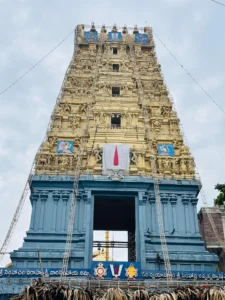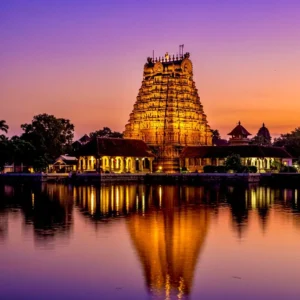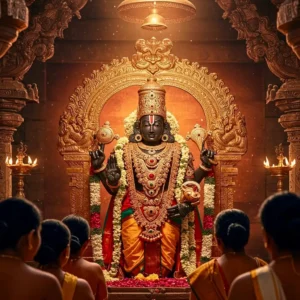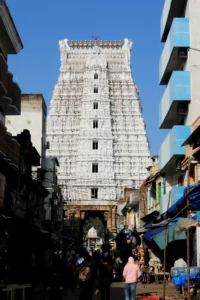Before I set foot in South India, I thought temples were all the same: silent halls, a few rituals, and out you go. I couldn’t have been more wrong. When I arrived, I realized I wasn’t just about to visit buildings; I was walking into centuries of belief, art, and timeless devotion.
There’s something in the air here. Maybe it’s the mix of temple bells and incense. Or maybe it’s just the quiet reverence with which locals treat every shrine and sanctum. Either way, if you’re even a little curious about faith or history, South India pulls you in.

Table of Contents
ToggleTemples in Tamil Nadu
I began in Tamil Nadu, often called the “temple state” of India. And rightly so, it’s packed with some of the best temples in South India. Tamil Nadu temples are a world in themselves, from tiny shrines tucked away in villages to massive complexes visited by thousands daily. Each one feels unique. Some are covered in vivid sculptures; others are built entirely of stone. And the energy? Depending on where you go, it ranges from peaceful silence to intense spiritual buzz.
Madurai Meenakshi temple
One of the first places I explored was Madurai. I’d heard stories about the Meenakshi Amman Temple, but no photo or travel blog really prepared me for the scale. The gopurams, those towering entrance structures, were like something out of a myth. Covered in colorful, detailed statues, they watched over everyone walking in.
I found myself standing still at the entrance for several minutes. It was early morning, but the temple grounds were already alive. Priests moved quickly through side passages. Women laid rangolis on the floor. The chants from the inner sanctum floated through the hallways like a whisper. I didn’t rush through this temple like other historical sites. This one asked for more time, and I gave it.

Brihadeeswara temple
After Madurai, I made my way to Thanjavur. Another gem among Tamil Nadu temples, the Brihadeeswarar Temple stood proudly under the blue sky. Built by the Cholas over a thousand years ago, this temple wasn’t just sacred and brilliant in structure. You could stand in one corner of the courtyard and hear someone whisper from across the space.
It didn’t matter that I wasn’t from the region or knew every ritual. The feeling of standing there barefoot, sunlight on my face, surrounded by stone walls that had seen generations, was humbling. It made me realize that these places were never just about prayer. They were about memory, tradition, and connection.
After a few temple stops, I noticed that these structures follow the principles of Dravidian temple architecture. It’s hard to miss once you know what to look for: tall pyramidal towers, pillared halls, and elaborately carved ceilings. The architecture isn’t just beautiful, it serves. It guides sound, channels light, and influences energy flows through space.
But Tamil Nadu wasn’t the end of the journey.
Temples in kerala
I traveled west into Kerala, curious about how the temples there would feel. I’d read a bit about the famous ones, like Guruvayur and Sabarimala, but nothing quite compares to being there. Kerala’s famous temples have a different vibe altogether. They’re simpler in design, more subdued in color, and built in harmony with the landscape. Thick wooden beams, sloping tiled roofs, and lamps lining the paths give them a quiet dignity.
The Magic of Dravidian Temple Architecture
Unchanged from your preferred version onward
Sitting by a temple tank one evening, I thought about what ties all these places together. It’s the architecture, yes, but also something more profound. Dravidian temples aren’t just buildings. They’re blueprints of the universe. Every sculpture, every corridor, has a purpose.
The gopurams act like gateways between the physical and the divine. The sanctum is built at the energy center. Even the temple layout often matches cosmic maps. I learned this from a local guide in Kanchipuram. He spoke of planetary alignments and sacred geometry as common knowledge.

Why Do South Indian Temple Tours Feel Like Inner Journeys?
If someone asked me why I took this trip, I’d say I was searching for meaning, connection and something ancient and authentic. South Indian temple tours offer more than photos and souvenirs. They change you. They ask you to slow down, observe, and feel. Whether you’re drawn by history, architecture, or spirituality, the temples of Tamil Nadu and Kerala will meet you halfway. You don’t have to believe in gods. Just bring your curiosity. The rest unfolds on its own.
Leaving behind the towering temple cities of Tamil Nadu, I found myself on a slow train bound for Kerala. As the sun rose, the landscape began to soften, coconut groves stretching endlessly, narrow canals glistening like silver threads. It felt like the land itself had exhaled. Where Tamil Nadu’s energy was bold and commanding, Kerala seemed to whisper its devotion.
I didn’t know what to expect from this part of the journey. But my instinct said the temples here would speak a different language, perhaps one of quiet reverence.
Ambalapuzha Sree Krishna Temple
My first stop was the Ambalapuzha Sree Krishna Temple, tucked away in a town where life moves at its own pace. A man at a roadside stall had told me, “Try the payasam there, it’s blessed.” He wasn’t exaggerating. The temple, modest in structure compared to the Tamil Nadu temples, had sloped tiled roofs and an air of peace that wrapped around you like a familiar melody. Inside, the deity sat in serenity, and offering a bowl of warm, milky sweetness felt like a memory you didn’t know you had. That moment stayed with me.
Vaikom Mahadeva
What struck me most about the famous Kerala temples was their quiet humility. At the Vaikom Mahadeva Temple, for example, I walked in expecting grandeur and was met instead with stillness. Families lit lamps together. Nobody hurried. The aged and weather-worn walls held centuries of worship in their silence. I didn’t need a guide here. The place taught me everything by simply existing.
While the Dravidian temple architecture of Tamil Nadu dazzles with scale and symmetry, Kerala temples blend into the environment like they were always meant to be there. Wooden ceilings, cool granite floors, lamps flickering in open courtyards, every element spoke in whispers. There was beauty, but no need to boast. Here, spirituality seemed to flow like the backwaters, slow and steady.
While riding through the backwaters near Alappuzha one afternoon, my boatman mentioned a small shrine hidden among banana groves. It wasn’t famous. In fact, it didn’t even have a proper name, just “the snake temple,” he said. Curiosity won, and we walked along a muddy path until we reached it.
The shrine was surrounded by dense greenery, and dozens of stone idols shaped like serpents lay under a giant tree. A woman in a red sari was lighting incense. She offered me a flower without a word. I didn’t believe in snake worship but took it with both hands. Sometimes, respect is its own kind of faith.
Sabarimala Temple
The real test of my endurance came when I planned a short trek toward Sabarimala. I didn’t do the full pilgrimage years of tradition; a strict 41-day preparation isn’t something to jump into lightly. But even the smaller trails, winding through forest and mist, gave me a glimpse of what thousands of men experience yearly. I met a group from Kochi who shared water and stories. “The journey matters more than the destination,” one said. I nodded, not just to be polite, but because I genuinely felt that.

Padmanabhaswamy Temple
In Thiruvananthapuram, the famed Padmanabhaswamy Temple called to me for its beauty and the mystery surrounding it. I had read about the sealed vaults and unimaginable treasures hidden beneath the temple floors. But standing in front of the idol, Vishnu in his reclining pose, none of that seemed to matter. The aura of the place wasn’t about gold. It was about presence. The three-door view of the deity forced me to see him piece by piece, head, body, feet, as if reminding me not to rush through the divine.
Despite Kerala’s charm, I couldn’t resist drifting back toward the coast of Tamil Nadu. The Kanyakumari Amma Temple, where three oceans meet, pulled me in. The sea roared outside, but inside the shrine, silence took over. The legend of the goddess waiting for her groom fascinated me. Some say she was left at the altar, but the locals describe her with strength, not sorrow. A priest explained, “She chose devotion over marriage. That’s not abandonment, it’s power.”
Nataraja Temple
After Kanyakumari, I returned to Chidambaram, home of the Nataraja Temple. Here, Shiva dances not in fury, but in cosmic rhythm. The statue of Nataraja was like nothing I’d seen before. Graceful and strong, it embodied movement frozen in bronze. The priest talked about the Chidambara Rahasya, the “secret” behind the golden curtain. When it was drawn aside, all I saw was empty space. “That’s Shiva too,” the priest said. “Formless, infinite.” I didn’t fully grasp it, but I felt it. And sometimes that’s more than enough.
Ekambareswarar Temple
By the time I reached Kanchipuram, I’d visited more temples than I could count. But this town, known for silk and spirituality, still surprised me. Among the best temples in South India, Ekambareswarar Temple stood tall, with its massive gopuram and a sacred mango tree said to be centuries old. A local woman told me the tree bore fruit of four different tastes, one for each season. “Even trees perform miracles here,” she smiled. I believed her.
Nearby, the Kamakshi Amman Temple offered a softer kind of strength. Devotees stood patiently, each whispering prayers only they understood. There were no loud chants, no grand processions, just quiet offerings, like ripples on water.
Throughout my journey, I had signed up for no official South Indian temple tours, yet each step felt guided by strangers, intuition, and something older than maps. The Tamil Nadu temples gave me awe. The famous Kerala temples gave me stillness. Both gave me faith not always in gods but in people, places, and the stories they carry.
My final days in South India were quieter. The rush to visit one more temple, capture one more photo, or listen to another myth had faded. I wasn’t chasing divinity anymore. I was walking beside it, feeling it in the spaces between silence and sound, shadow and light. What began as a travel plan had become hard to explain in neat sentences. Still, I’ll try.

Annamalaiyar Temple
I stopped in Tiruvannamalai, where the Annamalaiyar Temple stands at the base of a sacred hill. Unlike Madurai’s grandeur or Kanyakumari’s coastal magic, this place carried an ancient, elemental energy. The temple is dedicated to Shiva, one of the five elements of the Dravidian temple’s architecture belief system. I didn’t climb the hill as many do, but I walked the girivalam path, circling it barefoot like pilgrims have done for centuries. The ground was warm, the breeze gentle, and every step felt like a word in a prayer I didn’t know I knew.
In these temple towns, spirituality isn’t just something people believe, it’s something they live. It’s in the way they light lamps at dusk, place jasmine in their hair, and bow their heads to stone idols and each other. This way of life, though steeped in ritual, isn’t rigid. It moves, breathes, and evolves like the gods dancing, sleeping, or standing in stillness inside the shrines.
Why South Indian temples?
As I traveled, I began to understand how South India’s temples are not just places of worship—
They are archives of time. Every carving, mural, and festival is a chapter in a living book. The best temples in South India don’t just show you what people believe; they show you how they’ve survived through war, weather, politics, and progress. And they’re still standing, not just because of stone, but because of faith.
It would be wrong to say I found all the answers during my travels. In fact, I found more questions. But pilgrimage isn’t about ticking off destinations or collecting spiritual souvenirs. It’s about letting places change you in small, lasting ways. It’s about listening to bells, chants, stories, and silences.
Personal Experiences
I met an old man outside Srirangam who sold sacred ash in little packets. When I asked him if he went inside the temple daily, he smiled and said, “No need. God comes out here, too.” That stayed with me. Because sometimes the holiest moments don’t happen under a gopuram or inside a sanctum. They happen in dusty lanes, tea stalls, and quiet riverbanks.
Many travelers ask for lists: “What are the top five temples? Which is the most powerful shrine? Where should I go first?” I understand the need for structure, but if you ask me, the answer is simple: go anywhere. Or everywhere. Each temple, grand or humble, has something to teach. Just show up with open eyes and a willing heart. The rest will follow.
If you’re planning South Indian temple tours, don’t just book the famous ones. Leave room for surprises. Visit the small shrine behind a vegetable market or the neglected stone mantapa near a village pond. Speak to locals. Eat temple food. Walk barefoot when you can. Let the journey stretch beyond the guidebooks.
And when you return, as I did, you may find that the temples haven’t left you. Their smells, songs, and silences stay tucked in the corners of your memory. And sometimes, without warning, you’ll recall the shade of a banyan tree, the clang of a bell, or the peace of sitting cross-legged in a darkened sanctum.
In the end, the temples of South India gave me more than stories to tell. They gave me stillness. They reminded me that the sacred doesn’t always need translation. Sometimes, it just needs to be felt.


